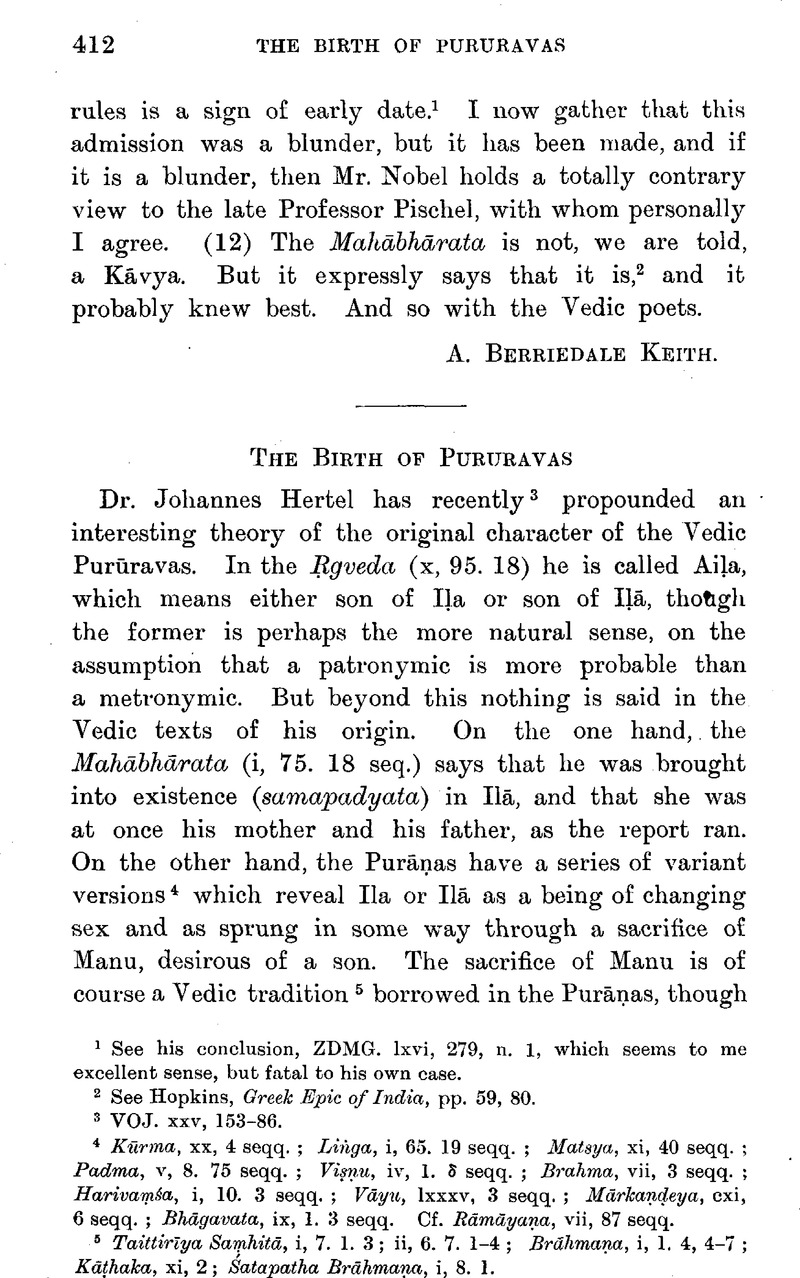No CrossRef data available.
Article contents
The Birth of Pururavas
Published online by Cambridge University Press: 15 March 2011
Abstract

- Type
- Miscellaneous Communications
- Information
- Copyright
- Copyright © The Royal Asiatic Society 1913
References
page 412 note 1 See his conclusion, ZDMG. lxvi, 279Google Scholar, n. 1, which seems to me excellent sense, but fatal to his own case.
page 412 note 2 See Hopkins, , Greek Epic of India, pp. 59, 80.Google Scholar
page 412 note 3 VOJ. xxv, 153–86.Google Scholar
page 412 note 4 Kūrma, xx, 4Google Scholar seqq.; Liṅga, i, 65. 19 seqq.Google Scholar; Matsya, xi, 40Google Scholar seqq.; Padma, v, 8. 75 seqq.Google Scholar; Viṣṇu, iv, 1Google Scholar. δ seqq.; Brahma, vii, 3 seqq.Google Scholar; Harivaṃśa, i, 10. 3 seqq.Google Scholar; Vāyu, lxxxv, 3 seqq.Google Scholar; Mārkaṇḍeya, cxi, 6 seqq.Google Scholar; Bhāgavata, ix, 1. 3 seqq.Google Scholar Cf. Rāmāyaṇa, vii, 87 seqq.Google Scholar
page 412 note 5 Taittirīya Samhitā, i, 7. 1. 3Google Scholar; ii, 6. 7. 1–4; Brāhmaṇa, i, 1. 4, 4–7Google Scholar; Kāṭhaka, xi, 2Google Scholar; Satapatha Brāhmaṇa, i, 8. 1.Google Scholar
page 413 note 1 See Caland, , VOJ. xvii, 351Google Scholar; Winternitz, ibid. 292.
page 413 note 3 ZDMG. viii, 455Google Scholar seqq., and in his edition of the Pañcatantra (i, § 9).
page 413 note 3 Golther, , Handbuch der germanischen Mythologie, pp. 416 seqq.Google Scholar
page 413 note 4 The evidence is, in itself, quite insufficient, consisting only of a few Brāhmaṇa phrases (Maitrāyaṇī Saṃhitā, i, 6. 3Google Scholar; Śatapatha Brāhmaṇa, viii, 4. 2. 1Google Scholar), where metaphoric terms are used of Prajāpati's creative action.
page 413 note 5 Here, again, Hertel's view is not in accord with the best authorities on Greek religion.
page 414 note 1 Böhtlingk is blamed for not noting this form, but he could not do so as the Kāṭhaka was not printed until 1900.
page 415 note 1 Indische Studien, xiii, 22Google Scholar, n. 5, 47, n. 2. See also Wackernagel, , Altind. Gram, ii, 1. 134, 135Google Scholar; Macdonell, , Vedic Grammar, pp. 75, 76.Google Scholar
page 415 note 2 Op. cit. 49.
page 415 note 3 VOJ. xxv, 183.Google Scholar
page 416 note 1 See Macdonell, , Vedic Mythology, p. 139.Google Scholar
page 416 note 2 It is normally assumed to have this sense, so by Eggeling, Macdonell (Vedic Mythology, p. 124Google Scholar), Geldner, etc.
page 417 note 1 Cf. Āyu's parallelism with Apāṃ Napāt, emphasized by Geldner, , Vedische Studien, i, 275Google Scholar. Compare also Agni's close relationship with Purūravas (Ṛgveda, i, 31. 4Google Scholar), and with Āyu (śaṃsam Āyoḥ, iv, 6. 11Google Scholar; cf. ii, 4. 2). Moreover, in Kāṭhaka, viii, 10Google Scholar, Āyu and the fire are closely connected (cf. Weber, , Indische Studien, iii, 463Google Scholar; Geldner, , op. cit. i, 248).Google Scholar
page 417 note 2 Geldner, (op. cit. i, 283)Google Scholar admits this, and neither Bloomfield (JAOS. xx, 183Google Scholar) nor Oldenburg (Ṛgveda-Noten, i, 338Google Scholar) solves the difficulty.
page 417 note 3 See Rgveda, v, 62. 5, 6Google Scholar; vii, 64. 2.
page 417 note 4 That the other Samhitās borrowed from the Śatapatha is most improbable; they would doubtless have taken the metaphor of daughter if they had. The Satapatha is no doubt the later text.




